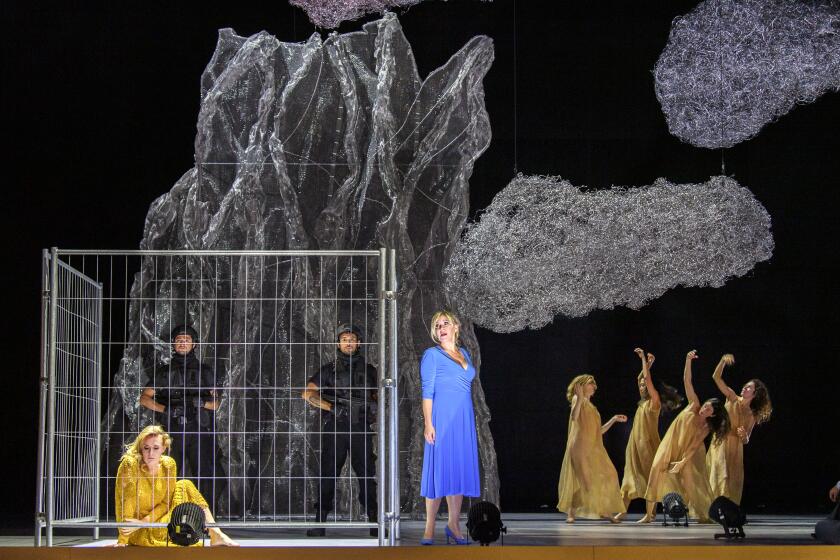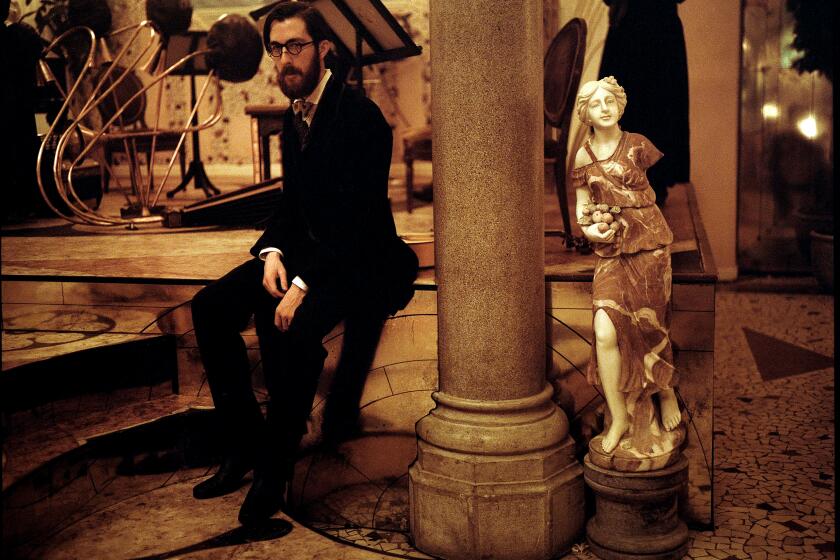The L.A. Phil just finished its best fall season in memory. How three maestros made magic

- Share via
This time last year, the Los Angeles Philharmonic, with remarkable post-COVID robustness, boasted the biggest budget of all orchestras. It was the most venturesome and inventive, with unusually diverse programming and audiences. Orchestras around the world looked up to it.
Then in early February the fretting began. Gustavo Dudamel announced that when his contract with the L.A. Phil expires in 2026, he will become music director of the New York Philharmonic. Three months later, the orchestra’s ambitious CEO, Chad Smith, accepted an offer to head the Boston Symphony. Throughout the summer, there was a further exodus of administration staff.
How the board is progressing in its search for a new administrative head and music director, nobody is saying. You don’t look to boards for transparency.
Yet whatever the leadership crisis may foretell, the L.A. Phil just finished the most exceptionally led fall season — from the Oct. 5 opening to its last symphony concert of the year Sunday — in memory.
Eight of those 10 weeks featured Dudamel, conductor laureate Esa-Pekka Salonen and conductor emeritus Zubin Mehta. By the time Dudamel steps down in three years, the three conductors will have represented a full half-century of L.A. Phil leadership (17 years at the helm for Dudamel and Salonen; 16 for Mehta). They neatly span three generations, the 87-year-old Mehta being 22 years older than Salonen, who is 23 years older than Dudamel.
This is a remarkable triumvirate, three of the most exceptional and important conductors before the public today. Each has something different to say and a different way of saying it. Each gets a distinctive and immediately identifiable sound from the orchestra. One week it could be Dudamel’s L.A. Phil. The next, Salonen’s L.A. Phil. The following week, Mehta’s.
A new Berlin production of Charpentier’s 1693 opera “Medee,” with direction by Peter Sellars and sets by Frank Gehry, offers vital perspective for our times.
Yet taken together Mehta, Salonen and Dudamel demonstrated how the L.A. Phil became the transformative orchestra it is today. Unlike most orchestras, which typically attempt to reinvent themselves with each new music director, in L.A. the baton has been passed on to successors who, for all their individuality, nevertheless built upon all that had gone before.
Mehta has been a regular podium presence in L.A. for more than 60 years. Same goes for Salonen, who’s going on 40. Let’s hope Dudamel follows suit. Audiences adore all three, as do the musicians. The ambience in the hall for any of them this fall has been one of joy. Old music has sounded newly discovered. New music, and there has been a flood of it, felt nourishingly necessary.
Over these eight weeks, Dudamel and Salonen participated in the celebration of the 20th anniversary of Walt Disney Concert Hall and the orchestra’s involvement in the California Festival co-sponsored with the San Francisco and San Diego symphonies, in which new works entered into all programs. While Mehta contributed significantly to the L.A. Phil’s unique advocacy of new music during his music directorship, he stuck to standard repertory.
Dudamel paid special attention to Latin music, including two world premieres by Mexican composer Gabriela Ortiz. The first, as part of a program titled “Canto en Resistencia” (Singing in Resistance), was a vivid orchestral version of an earlier chamber piece, “Seis Piezas a Violeta,” based on songs by the Chilean singer-songwriter and folklorist Violeta Parra.
Because the film deals with death and reanimation, the composer favored instruments that rely on human breath and others that he then manipulated to “a really unnerving effect,” he says.
The other was a 45-minute feminist story ballet score of grand proportions and striking revolutionary intent. The inspiration for “Revolución Diamantina” (Glitter Revolution) was the 2019 protest in Mexico City in which marchers threw pink glitter at the chief of police, whose officers had allegedly raped a woman with impunity.
The densely intricate dance scenario takes on major societal issues while supplying its own vast repertory of captivating, glittery musical effects. With this score and Thomas Adès’ “Dante,” which was released on recording in April and is ripe for a Grammy next month, Dudamel and the L.A. Phil have in the last couple of years produced the two most significant and magnificent large-scale ballet scores since the mid-1950s (when Benjamin Britten wrote “The Prince of the Pagodas” and Hans Werner Henze wrote “Ondine”).
Salonen had new music and a great performance of a ballet score, as well. As part of the Disney anniversary celebrations, Dudamel conducted Salonen’s “Fog,” the title of which stands for the initials of Frank O. Gehry and is a winningly whimsical departure on the prelude from Bach’s E-Major Partita for solo violin, the first music played on the Disney stage while the hall was under construction in 2003. This time, as part of the opening night gala, Lucinda Childs choregraphed a stunning solo dance, which she performed.
A few weeks later, Salonen himself premiered a new piece, “Tiu,” a Nordic word used in counting eggs. Here, the composer counted years, 20 for Disney, with a sequence of 20 chords, used in various sequences, this way and that, and as palindromes. The hall came alive. Trumpets spread out around the auditorium; bass notes in the orchestra rose as if from profound depths; enticing melodies came out of nowhere, and piccolos and glockenspiels imagined a wondrous twinkling of night light on Disney’s steel, were the Music Center ever to properly light the building.
On a later program, Salonen led an earthshaking performance of his Dada-inspired “Karawane” for chorus and orchestra that brought the house down. Both pieces were recorded live, as were the new Ortiz scores.
In other ways, three orchestral blockbusters told the story of the three maestros. Dudamel’s performance of Stravinsky’s “The Firebird” was a marvel of replicating in sound, bringing the Russian fairy tale and its lush setting. Salonen brought a spiritual and erotic rapture to the full score of Ravel’s ballet, “Daphnis and Chloé.” Mehta made everything in Mahler’s First Symphony — also a descriptive, nature-inspired score — pop out, as if in 3-D.
Where the L.A. Phil goes from here obviously remains to be seen. But the lesson this fall is clear. The world likes to accuse L.A. of being a tacky, superficial town that lacks a sense of tradition. Yet the success story of one of the most admired arts institutions in the nation has been the steady building of innovation on tradition. With a valid tradition of the new, we have no need for artificially reinventing the orchestra any more than the wheel or human intelligence.
Oscar winner Fernando Trueba and celebrated artist Javier Mariscal investigate a real-life musician’s disappearance in the animated “They Shot the Piano Player.”
More to Read
The biggest entertainment stories
Get our big stories about Hollywood, film, television, music, arts, culture and more right in your inbox as soon as they publish.
You may occasionally receive promotional content from the Los Angeles Times.














